To read “Stargazing on Vamizi Island Part One” which includes a description of the island, the villas and activities available on the island, as well as sky conditions, the telescope equipment I took with me, and the observing report of the early evening session which proved to be exceptional, please click here.
Though there had been a few early showers, the cloud had started to break up my mid-morning, such that by the time we journeyed to another distant beach for our second lunchtime castaway picnic, I was becoming hopeful that I might be able to squeeze in another of my planned three sessions. After we concluded a BBQ on the beach, the sky was completely clear so I hurried back to our bedroom to grab my scope.
The Midnight Session
In reality the session began around 10:30pm with the intention to finish around 1am. By then the central region of the Milky Way including those constellations such as Scorpius and Sagittarius which contain a veritable treasure trove of DSOs were riding around 60o altitude, as was majestic Saturn, located in the constellation that all astrologers conveniently choose to ignore, Ophiuchus. This time, my hunting ground would be the courtyard of the villa.
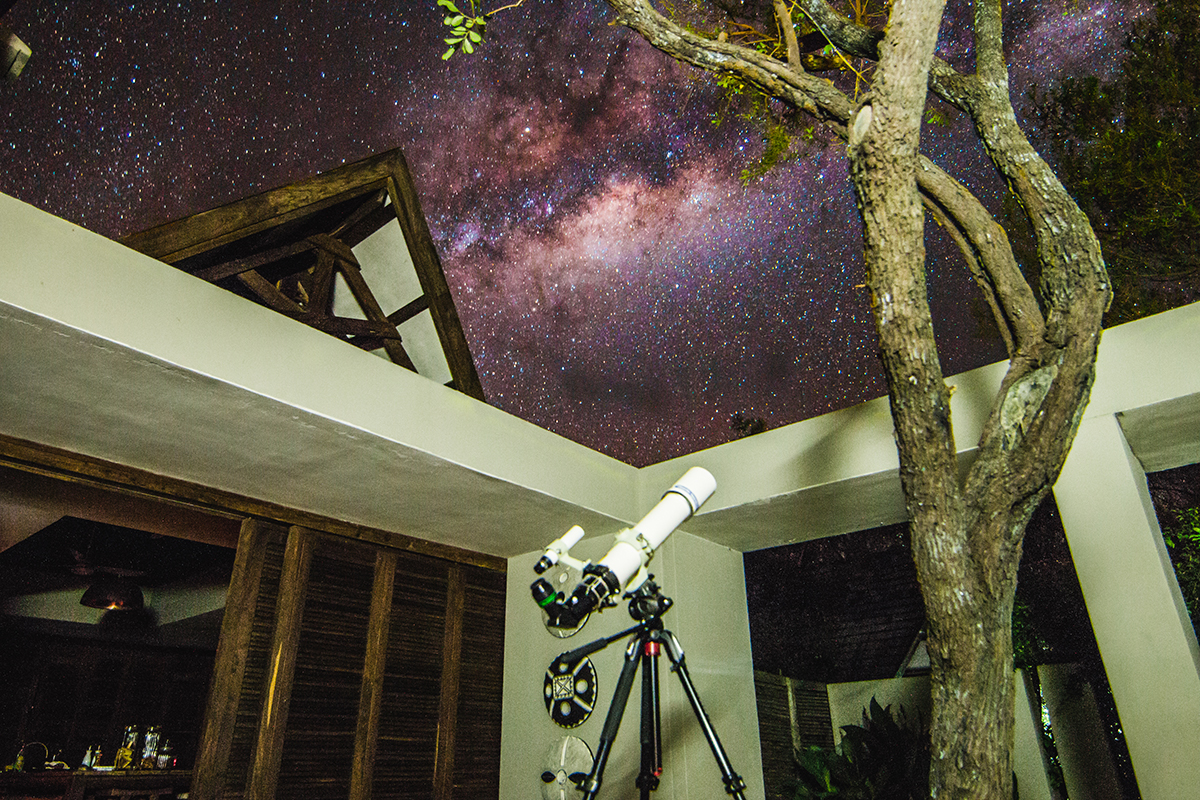
A single 30 second exposure taken in the courtyard of our villa, with the foreground briefly illuminated with a flash from my iPhone.
First up were two showpiece open clusters located in Scorpius, M6 and M7. Messier 7 (NGC 6475) has been known since antiquity, having first been recorded by Ptolemy in the 2nd century AD, and now bears the colloquial name Ptolemy’s Cluster. I actually like to spend a moment observing this cluster naked eye, as it is arguably the location of brightest condensation in the central Milky Way. With several stars brighter than magnitude +6, it is possible with a little effort to actual resolve a few of these brighter members with no optical aid, though given the cluster sits atop a dense stellar region near the core of our home galaxy, it is harder than the numbers would suggest. With a diameter of 80 arcminutes, this cluster is best enjoyed with a wide field, so I used the 24mm Panoptic. The telescopic appearance is beautiful. There are around 80 cluster stars in the field with the brightest members contained near the centre, with several chains of stars zig-zagging away from the core. What I find really draws the eye is an extreme colour contrast. All the stars bar one, are blue-white, but the single brightest member, as though wanting to draw even more attention to itself, is a yellow G8 class star.
Only around 3.5o away, M6 (NGC 6405), is almost twice as distant as its neighbour at around 1,600 light years, and has an apparent diameter of 20 arcminutes, so I switched to 7mm Nagler which nicely framed the cluster and helps to reveal a stellar arrangement in the shape of a butterfly motif as might be found in a child’s dot-to-dot drawing book, giving the cluster its name. While the OC does not possess any members that have the striking brilliance of M7, it is still easily visible to the naked eye, but what really draws my attention in the telescopic view is the almost completely black background. This is starkly different to M7 which is cradled in the light of millions of background stars. Despite the limited separation on the night sky, M6, appears to be a piece of the Milky Way which has broken off and is slow drifting away in the sea of black that is lapping against the land mass of the core of our galaxy.
This region of the sky is actually very busy with open clusters, and even sweeping with just a 1-degree field, you will stumble across numerous pretty little gems, never needing to refer to a star atlas to hunt down the next target. After a few minutes sweeping around the area, enjoying the views, but never really knowing what I was actually observing, I decided to hop the border into Sagittarius to visit two spectacular nebulae, M8 and M20.

Not a night for stargazing, but our sunset (sans sunset) champagne cruise aboard a traditional Dhow was memorable.
Perhaps it is a British thing, but the teapot asterism in Sagittarius is probably the most obvious in the sky after the Plough in Ursa Major, even when it appears upside down, yet I have stargazed with people from other parts of the world and they often struggle to see it. The Milky Way actually appears to be the steam emanating from the spout of a freshly brewed pot of celestial tea, and M8 is rather conspicuous to the naked eye as a denser region of this “vapour.” With dimensions of 90 arcminutes by 40 arcminutes, the Lagoon Nebula needs a widefield so I switched back to the 24mm panoptic. The nebula itself is bisected by a dark lane, which gives its name, and creates appearance of two separate nebulae side by side. While one side is peppered with a few bright stars against the bright background of twisting and folding gas, the other side of the dark channel is dominated by a young open cluster (NGC 6530) to which the nebula gave birth, but has not yet released its grip with tendrils of greenish gas wrapping them like a baby in a blanket.
While I did switch to the 7mm Nagler to take a closer look at open cluster, it was not long before I switched back to the 24mm. By using such a widefield to initially explore the Lagoon, I had also encompassed its nearby cousin, the Triffid Nebula in the same field. Two Messier objects for the price of one, is not something you can often achieve. Poor little M21, a small open cluster of just 14’ across was barely noticed in the same field, such is the draw of the two clouds of glowing gas.
M20 is one of the most interesting DSOs in the sky as it is actually made up of an open cluster, an emission nebula, a reflection nebula and a dark nebula that slices the emission region into three which gives the object its name. Despite all these different components vying for your attention, it really is the bisecting dark lanes over the bright, glowing clouds of hydrogen that draw the eye. While my 3” scope was unable to deliver enough light to my retina to reveal the pinkish glow so well shown in long exposure photos, it is one object that really does appear to the eye as it does in a picture. Though dwarfed by nearby M8, the nebula itself is almost the size of the full moon and I found the 7mm showed it best. The small open cluster sits at the heart of the emission nebula with one of the dark lanes sweeping around it. The reflection nebula appeared slightly detached with a darker region cleaving it away from the glowing hydrogen gas, which is a little different to photos which seem to show a gradual transition from glow to reflection.
Sagittarius is not just about glowing clouds of gas and the young clusters they form. It is also home to some of the most ancient structures in the universe, globular clusters. There are actually numerous GCs in the Archer, but I only viewed two, M69 and M70.
M69 is a simple hop of only a few degrees from the bright star Kaus Australis, which forms the southern end of the bow, and is also the base of the spout of the teapot. At just under 10’ in diameter, M69 is one of the smallest and dimmest globular clusters in Messier’s catalogue. Using the 6mm settling of the Nagler Zoom, the cluster had a slightly granular appearance, with a gradual brightening to an almost stellar core.
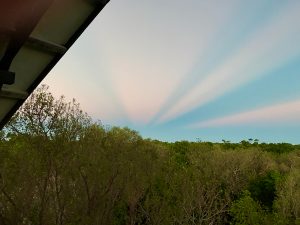
One of the most obvious displays of anti-crepuscular rays I have ever seen, captured from the observation tower.
Sticking with 6mm, approximately 2 degrees further in the same direction from Kaus Australis, is M70. Presenting a very similar appearance in the eyepiece, the view is actually reflective of the comparable physical characteristics of each cluster, with both lying approximately 30,000 LY away and subtending around 9-10’ on the sky thanks to similar actual diameters of around 70 light years. Herschel described the cluster as a miniature M3, but in my tiny Takahashi at least, that felt like a generous accolade to bestow.
As I was considering my next deep sky target, quite possibly M54, another globular a few degrees further still into the depths of Sagittarius, I was distracted by a yellow-green flash of light in my peripheral vision. Turning my gaze quickly to my left, I spotted another flash and then another. I was temporarily joined by a couple of fireflies, who put on a little light show that briefly rivalled the light of the stars in its beauty. Clearly, they felt, like the dozens of small crabs that had distracted me during my evening session, that they should momentarily pull my attention away from the heavens. With no offence to the crabs, these were far prettier. As they weaved their way over the roof of the kitchen, I turned my attention back to the sky, but had completely forgotten what was next on my hit list. I decided to head back into the scorpion.
Lying only 1.3o west of Antares, M4 is probably the easiest globular clusters to locate. At a distance of only 7,200 light years, it is also one of the closest and brightest. Messier himself was actually able to partially resolve the cluster with his modest telescope, making it the first GC to be resolved into its stellar components, and I was able to do the same. Using the 7mm Nagler, the cluster filled the central half of the 1-degree field, and I was able to glimpse the small central “bar” of 11th magnitude stars that is such a prominent feature in larger instruments. Though intrinsically, not dissimilar to M69 and M70, it presents a vastly superior view in the eyepiece thanks to a proximity that is 4-times closer.
Returning to Antares as a starting point, around 4.5o NW lies another globular, M80. William Heschel described it as one of the richest and most compressed clusters he had seen. While I was not able to resolve the cluster into individual stars, it presented a mottled appearance, but the compression Herschel spoke of was obvious. Gradually brightening from the edge inwards, there is a sudden ramp in intensity upon approach to the centre where it appears like a flashlight has been switched on.
Saturn is not well placed for observation from the UK currently, and with the planet around 70o above the horizon, I was not about to pass up an opportunity to view the most beautiful of planets, so a short detour back to the confines of our celestial backyard was in order. While seeing conditions were not quite the same level as the early evening session when Jupiter put on a fantastic display of detail, it was still very pleasing. I was able to comfortably use the 4mm (143x) setting of the Nagler Zoom and for brief moments, the 3mm setting (190x) to observe delicate banding on the disc of the planet, the Cassini Division and possibly in very tranquil moments, some shading differences in the rings themselves.
Having satisfied my planetary cravings for another night, I put the star charts away and just using the 24mm Panoptic, starting sweeping in the constellation of Scutum. Even after many years of stargazing, it is not a constellation I am particularly familiar with, which meant I was in for a surprise only a minute or so after I began my unguided exploration of the shield. The constellation sits along the Scutum star cloud so the view is almost always filled with tiny sparkling stars, and hence quite rewarding to pan across. However, I suddenly came across a stunning open cluster, which seemed to have hundreds of members, in a fairly compact region of sky, perhaps 15-20’ across. After taking in the view for perhaps a minute, I found myself reaching for two pieces of equipment. My 7mm eyepiece for a closer look and my star chart so I could identify what I was looking at. Turns out, it is rather famous, just not to me apparently!
M11, is one of the richest and compact open clusters in the sky, containing over 2,900 stars with more than 600 exceeding magnitude +14. At first glance the cluster appeared larger to me than the reported dimensions, which I assume is due to busy background sky. The object itself is beautiful. The stars appear twisted into knots and clumps with some dark lanes which are conspicuous by the absence of stars. The common name of this cluster was given by Admiral Smyth, who noted a fan-shaped appearance that resembles a “flight of wild ducks.” Taking some time to concentrate on the view, I think I can see where the admiral was coming from, but it certainly did not jump out at me. Less than a degree away and hence in the same field, was small open cluster NGC 6704, though the small 5’ cluster was barely able to catch my attention from what is now one my favourite open clusters. Resolving that I must take more opportunities to view M11 in the future, I switched back to the 24mm and continued my random walk across unfamiliar lands. It didn’t take long before I stumbled across two more showpiece DSOs. However, nebulae are my favourite type of DSOs so I am more likely to recognise an unexpected interloper in my eyepiece. M16, the Eagle and M17, the Swan nebula both just fit in the field of view, with each hugging on side of the field stop. Just falling within the borders of Serpens, The Eagle Nebula is perhaps the most famous nebula in the night sky among the general public thanks to the wonderful “Pillars of Creation” photo from the HST. I have enjoyed some fabulous views of this object using a 12” scope in Namibia, where those “pillars” are on show. However, in the tiny Takahashi, the most prominent feature was actually the embedded open cluster of about 20 stars, with the nebulosity proving to be fairly elusive, though not invisible. I am in good company it would seem as the Herschels did not perceive any nebulosity, and as a result, their NGC catalogue, reports it only as a cluster.
The view of the Swan however, was far more pleasing to an emission nebula fan. Hardly surprising as M17 is the brightest emission nebula visible to observers from mid-northern latitudes after the Orion Nebula. My eye was immediately drawn to the long bright bar which makes up the body of the swan. It is a rich nebula with twists and knots which almost take on the appearance of plumage in the bird, as it glides along the celestial river of the Milky Way. What surprised me most however, was how distinctive the “hook” feature which makes up the head of the swan was. In long exposure photos, and larger aperture scopes used visually, there is quite a lot of nebulosity trailing the hook above the bar which to my eye at least diminishes the impact of the head. However, in the smaller scope, this fainter emission region was only really visible with averted vision, which really allowed the full splendour of the swan to stand out.
Being engrossed in the delights of Scutum and its neighbour’s borders, that I had failed to notice that small, thick clouds had started to appear around 11:45pm. Slowly their numbers increased and they began blotting out the delicate light of the Milky Way. By midnight, only the brightest stars were visible as hazy points through the cloud, so I decided to call it a night and get some well-deserved rest. It was the right decision, as before I drifted off to sleep, rapid tapping sounds on the roof our bedroom suggested I would have been scrambling for cover with my telescope if I had continued to chase the “sucker holes,” a pursuit all too familiar to UK-based astronomers.
The Morning Session
After a slightly truncated midnight session due to the arrival of clouds and rain, I decided to start the morning session around 2:30am with the aim of watching the sun rise. Once again, the courtyard in the villa was the venue of choice, though I would also spend some time in the observation tower to view some objects which remained stubbornly low in the sky before sunrise.
One object above all others was the main reason to wake for, and that was the globular cluster 47 Tucanae / Caldwell 106. The second brightest GC in the heavens, appearing 60% larger than the full moon, in my opinion, it is the cluster to beat them all. C 106 is in fact 3x brighter and 30% larger than the M22, the most impressive Messier GC, and really is an object that all astronomers should see at least once. Nicolas-Louis de Lacaille is recorded as having swept up 47 Tuc in an ½ inch 8x telescope, initially thinking it was the nucleus of a bright comet. Even using my 8×30 finder it is an impressive sight, and I can understand why Lacaille thought this, as the cluster’s intense core is surrounded by a delicate halo. Switching to the scope and 7mm Nagler for a 1o field, the globular almost filled almost 2/3 of the view. Unlike Omega Centauri which is fairly homogeneous across its width, 47 Tuc rises in intensity to an extremely bright, tight core a few arcminutes across. It is almost like looking directly down the beam of a torch. That core is surrounded by thousands of tiny sparkling diamonds which were well resolved in the 3” scope.
The constellation of the bright, large billed bird, the Toucan, actually harbours a second noteworthy globular in the form of NGC 362 / C 104, which like 47 Tuc, also flanks the Small Magellanic Cloud. Just about visible to the naked eye at magnitude 6.4, this GC would probably be better known, were it not sitting in the considerable shadow of C 106. Appearing far smaller than its nearby cousin, I used the 6mm setting of the Zoom EP. I was unable to resolve the cluster, though there was hints of mottling and texture, but the central core almost appeared like a single bright star. The cluster itself is known to have a particular dense core, which has likely saved it from tidally being torn apart given the eccentric orbit the cluster has which brings it dangerously close to the galactic centre.

Taken before midnight, the Milky Way stretches over our villa, in a single 30 second exposure, with the foreground briefly illuminated with a torch.
Before leaving Tucana, I decided to explore the small Magellanic Cloud. With an average diameter of 4.2o, it left me wishing I had taken a long focal length 2” EP to Vamizi, but sadly I could not spare the weight. The 24mm Panoptic had to suffice. Like its big sister, the LMC, several DSOs are observable in the SMC, even with a small scope. While most were nothing more than hints with a slight condensation against a uniform background of ghostly star light, one or two larger nebulae began to take on some structure with averted vision. Just being able to glimpse clusters and emission nebulae in another galaxy with such a modest aperture was reward enough for the 15 minutes or so, I spent sweeping around this satellite galaxy of the Milky Way.
After being joined on the beach by dozens of small crabs looking for their evening meal and a couple of fireflies in the midst of a courtship ritual in my midnight session, it was inevitable that I would once again have a close call with some of the local fauna. Just before leaving the tower for the first time, I heard some loud screeching. It was not the first time this had been heard, and perhaps somewhat naively, both of us had associated this noise with one of the larger bats that appeared every evening. This time, there were two banshee-like howls, followed by a flap, flap and then a thud. The thud was to my right, and immediately I fixed my gaze in that direction and reached for the switch on my headlamp. Two pairs of glowing eyes were staring back at me from the top of the second bedroom. Those eyes belonged to two large owls who were clearly interested in me. After a short no-blinking contest which they were winning, one of them decided it wanted a closer look, possibly to size me up as a potential night-time snack, and took to the skies heading straight for me. At the last moment, it diverted its path upwards and landed momentarily on the apex of the tower roof, before turning back and landing on the same bedroom roof. Then the second owl did the same. After both concluding I was too large to carry off, despite being 18-24” tall, they moved on and left me to my stargazing.
By this time, the central Milky Way was near the zenith, which also well placed the Summer Triangle from the courtyard, so I decided to spend some time with old favourites rather than explore the treasures of the southern hemisphere.
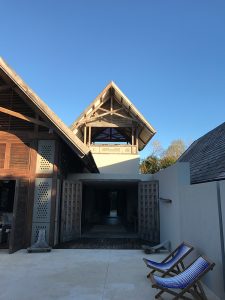
The observation tower in our villa, location of much of my early morning session and venue for my battle of wills with 2 owls.
Every time we stargaze, we travel back in time to see things how they were, not how they are, thanks to the vast distance scale of the universe and the finite speed of light. However, I like to think you can also travel forwards to see things how they will be, and I started with the ultimate fate of our own Sun, by heading to the planetary nebula, M57 in Lyra. Using the 7mm, a delicate smoke ring hovered against the background star field. With averted vision, it was also possible to just glimpse that the dark centre is actually not quite the sack cloth black of the surrounding night sky, but in fact glows with the feeble light of tenuous gas. Unsurprisingly, given 76mm of aperture, I was unable to see the hot, dying ember of a once stellar mass star which illuminates the surrounding gas with UV.
Next up was a globular cluster that until quite recently was thought to be a dense open cluster not unlike the Wild Duck Cluster. M71 in Sagitta is easily located on a straight line between the stars Delta and Gamma that partially delineates the celestial arrow. With the 6mm, a number of stars were seen which ordinarily might be thought of as interloping field stars, but here they typically are cluster members, all of which seemed to take on the appearance of a pointed “arrow head,” against a background condensation with granulation hinting at the many thousands of stars that make up this GC.
Before moving onto the most famous denizen of Vulpecula the Fox, I switched the 24mm Panoptic and swept down towards Collinder 399, better known as the Coathanger. A wonderful little asterism of unrelated stars, looks remarkable like its namesake. C 399 was nicely framed in the central third of the field, and enjoyably, “up-the-right-way” for a change as seen from the southern hemisphere in my scope.
Despite being a resident of the Fox, I have always hopped to M27, the Dumbbell Nebula using Gamma Sagittae as a starting point. From there it was not much more than one field width in the 24m movement to locate the planetary nebula. Once located, I switched the 7mm which revealed the bright central core and lobes at both ends which ebb away into dark space that give the planetary its name. While taking the magnification up using the zoom, increased detail in the central bar to reveal some twisting and contorting gas, it caused the fainter lobes to disappear from view as the expanded image resulted in their low surface brightness struggling to stand out against the background sky. Switching back to the lowest 6mm setting, I inserted the UHC filter to see if this would help. While it did intensify the core of the nebula, and revealed more of the “American Football-like” shell of gas that surrounds it, I actually preferred the unaided view.
With Saturn still more than 50 degrees above the horizon, I decided to have another quick look and found seeing conditions were better than in the previous session. Delicate banding on the disc was obvious, and some structure was seen in the rings, as were several moons. Staying with higher magnification, I decided to have a quick look at a few of the showpiece double stars in this region of the sky including the Double-Double in Lyra and Albireo in Cygnus. The latter has since been revealed by Gaia to be just a chance alignment on the sky rather than a true double. Even that knowledge does not diminish the beauty of that particular “double star.”
Once again putting away the star charts and switching back to the 24mm Panoptic, I elected to spend a good thirty minutes just sweeping around the star clouds of both Cygnus and the central Milky Way. It is such a busy area, that you cannot help but fall over cluster after cluster, and occasional nebula or GC. Most of the time I was just happy to enjoy the view rather than spend any precious seconds trying to identify what I had found. I did also return to some of the highlights from the midnight session including M20.
Around 4am, I decided to head back up to the observation tower to conduct a rematch of a prize fight I refereed in Namibia the year before. 47 Tucanae versus the great globular in Hercules, M13. This time however, it was going to be a tag team match by including NGC 362 in Tucana and M92 in Hercules. Both of the heavy-weights were around 20o altitude, while their bantam-weight partners waited in the wings. Once again, however, the contender from the north just didn’t have the goods to challenge the incumbent champion, and with the one-two-three punch, of larger size, brighter core, and more resolved members, 47 Tucanae sent M13 to the canvas. However, tonight was not a night where the bird with a large beak was going to whitewash the ancient Greek hero.
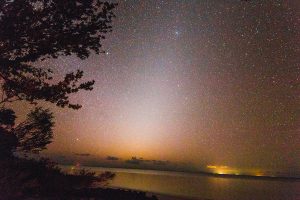
Taken during the evening, both dawn and dusk appearances of the zodiacal light were equally impressive. The only source of light pollution appears to the bottom right.
On paper, both NGC 362 and M92 are remarkably similar. Both have apparent magnitudes of +6.4 and both extend to around 14 arcminutes in size. M92 had a slight advantage as it was a few degrees higher in altitude, but we don’t accept excuses in the DSO battle arena. Starting with M92, the cluster appeared quite compact with a bright core that seemed to be emanating the stars into a slightly asymmetrical halo, with plenty of granulation and some resolution of component members using the 7mm eyepiece. Moving onto NGC 362, the view was similar to earlier in the night. The obvious concentration at the core appeared almost stellar, but was slighter smaller and dimmer than the core of M92, and I was still unable to confidently resolve any cluster members, having to settle for granulation and mottling as before. Despite similar reported attributes, I found M92 to provide a far more rewarding observing experience bringing the score to one-all. This time we will call the prize fight a draw.
By this time, Venus and Mercury were visible from the tower, and the “false dawn” of zodiacal light was as obvious as it had been in the evening sky many nights before, meaning my time under the stars would soon be at an end. Around 4am, a couple of birds broke out into morning song, apparently tricked by the ZL, though they quickly realised their mistake and fell silent for about another hour. Venus was almost 30 degrees above the horizon, showing almost a first quarter phase and some hints of cloud top detail in moments of tranquillity.
So rarely do I have a clear sky all the way to the horizon, that I will take any opportunity to view that most fleeting of solar system worlds, Mercury. At around 14o altitude, atmospheric dispersion was still playing havoc with any observable detail, but I was able to see a similar phase as shown by Venus just a few minutes before.
After finishing with the messenger of the gods, I decided to cap the scope and watch all the stars slowly fade from view as the rising Sun brought with it a new day.

Cocktail Vamizi enjoyed while watching the sunset at Villa Tartaruga, before enjoying pizzas on the beach.
Post Dinner Outreach
Towards the end of our honeymoon, I decided to do a little impromptu outreach one evening after dinner. While the staff were cleaning the kitchen and readying the villa to closed down for the night, I set up the scope in the courtyard. I then called our wonderful staff out hoping to blow their socks off. Only one target was in mind, and that was Saturn. I have heard too many superlatives and more colourful language from first time viewers of Saturn to pick anything else.
I decided to use the Nagler 7mm (81x) so the planet would not whip through the field to quickly, given I was using a manual mount. One by one, they stepped up, and either stunned silence or perhaps a gasp was the result. Stephen summed it up best. “That is a remarkable machine” in reference to the Takahashi FC-76. He is right. It is a fantastic little telescope.
Conclusion
Vamizi exceeded what were already incredibly high expectations. Everything from the spectacular scenery, luxury accommodation and activities to the incredible service, whether it was Josie, our lovely butler who would show up with a cocktail just as we were thinking of raiding the drinks cabinet, to Papi’s delicious food, and Stephen being ready to jump in our land cruiser at a moment’s notice to drive us to a random beach was without fault.
The stargazing was some of the best I have ever experienced. Not only does the location of the island mean all the treasures of the southern hemisphere night sky are within reach, as are many of the old favourites from the north, but they are delivered in one of the darkest skies I have experienced allowing you to enjoy their full splendour. One tip for anyone who might visit with the goal of lots of astronomy. The observation tower in Villa Tartaruga has no roof and offers a fully unobstructed 360o view of the sky and would be the perfect vantage point for stargazing. We enjoyed some time up there before our pizzas on the beach.
Vamizi gave us a honeymoon that we will never forget and I hope one day we will be able to return to this island paradise.






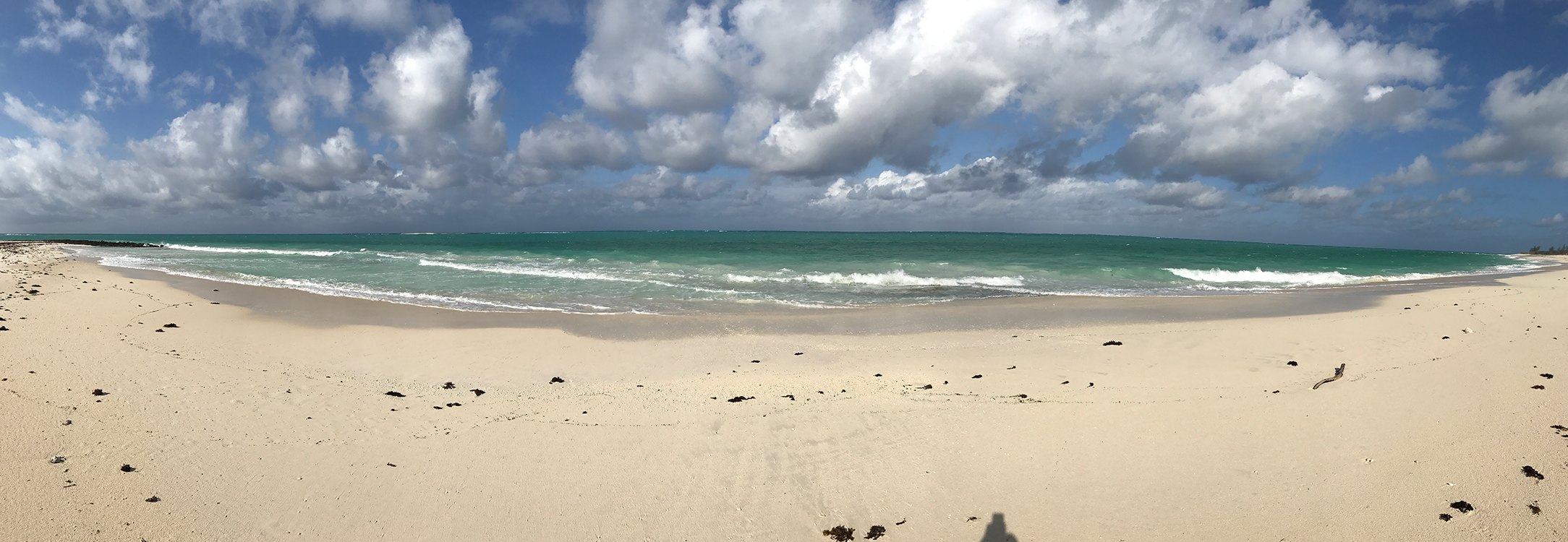



Pingback: Stargazing on Vamizi Island Part One | Alpha Lyrae